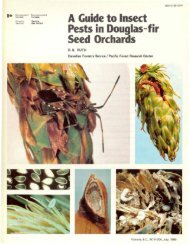the translocation of minerals in trees - Canadian Forest Service
the translocation of minerals in trees - Canadian Forest Service
the translocation of minerals in trees - Canadian Forest Service
You also want an ePaper? Increase the reach of your titles
YUMPU automatically turns print PDFs into web optimized ePapers that Google loves.
CANADA<br />
Department <strong>of</strong> Nor<strong>the</strong>rn Affairs and National Resources<br />
FORESTRY BRANCH<br />
THE TRANSLOCATION OF MINERALS<br />
IN TREES<br />
by<br />
D. A. Fraser<br />
<strong>Forest</strong> Research Division<br />
Technical Note No. 47<br />
1956
Published under <strong>the</strong> authority <strong>of</strong><br />
The M<strong>in</strong>ister <strong>of</strong> Nor<strong>the</strong>rn Affairs and National Resources<br />
Ottawa, 1956
CONTENTS<br />
PAGE<br />
INTRODUCTION. . . . . . . . . . . . . . . . . . . . . . . . . . . . . . . . . . . . . . . . . . . . . . . . . . . . 5<br />
RELATIVE ROLES OF XYLEM AND PHLOEM IN TRANSLOCATION. .. . . . . . . . . 6<br />
ADVANTAGES AND METHODS OF USING RADIOISOTOPES IN TRANSLOCATION<br />
STUDIES........ . . . . . . . . . . . . . . . . . . . . . . . . . . . . . . . . . . . . . . . . . . . . . . 7<br />
SUMMARY A D CONCLUSIONS...... . . . . . . . . . . . . . . . . . . . . . . . . . . . . . . . . .. 14<br />
REFERENCES. . . . . . . . . . . . . . . . . . . • . . . . . . . . . . . . . . . • . . . . . . . . . • . . . . . .. 15<br />
78786-i!
The Translocation <strong>of</strong> M<strong>in</strong>erals <strong>in</strong> Trees!<br />
Project P-377<br />
by<br />
D. A. Fraser<br />
INTRODUCTION<br />
Green plants manufacture <strong>the</strong>ir own food from carbon dioxide and water<br />
through <strong>the</strong> process <strong>of</strong> photosyn<strong>the</strong>sis. However, <strong>the</strong> presence <strong>of</strong> o<strong>the</strong>r elements<br />
<strong>in</strong> addition to carbon, hydrogen and· oxygen is essential both to <strong>the</strong> manufactur<strong>in</strong>g<br />
process and to <strong>the</strong> healthy development <strong>of</strong> <strong>the</strong> plant. For almost a century<br />
<strong>the</strong>re ,,,as a general as umption that only seven additional chemical elementsnitrogen,<br />
sulphur, potassium, calcium, magnesium, phosphorus and iron-were<br />
required. In <strong>the</strong> last decade, <strong>in</strong> addition to <strong>the</strong> ten elements which have been<br />
mentioned, several o<strong>the</strong>rs have been found to be essential.<br />
Carbon and oxygen are obta<strong>in</strong>ed chiefly from <strong>the</strong> air through leaves <strong>of</strong> <strong>the</strong><br />
tree, and <strong>the</strong> rema<strong>in</strong><strong>in</strong>g elements are absorbed from <strong>the</strong> soil by <strong>the</strong> roots and are<br />
translocated to o<strong>the</strong>r parts <strong>of</strong> <strong>the</strong> plant.<br />
Trees require <strong>the</strong>se essential elements for optimum growth, but <strong>the</strong> amounts<br />
and <strong>the</strong> time <strong>of</strong> <strong>the</strong>ir absorption from <strong>the</strong> soil depend on <strong>the</strong> species as well as<br />
on site conditions. S<strong>in</strong>ce silviculture is <strong>the</strong> art and science <strong>of</strong> cultivat<strong>in</strong>g forest<br />
crops, <strong>the</strong> forester must try to select treatments most appropriate to site conditions.<br />
It is true that empirical observations have greatly assisted <strong>the</strong> forester<br />
<strong>in</strong> assess<strong>in</strong>g <strong>the</strong> quality <strong>of</strong> site as reflected <strong>in</strong> <strong>the</strong> volume <strong>of</strong> merchantable timber.<br />
The study <strong>of</strong> m<strong>in</strong>eral requirements <strong>of</strong> tree species as well as <strong>the</strong> m<strong>in</strong>eral <strong>translocation</strong><br />
with<strong>in</strong> <strong>the</strong> tree will assist <strong>in</strong> site evaluation and recognition <strong>of</strong> diseases<br />
caused by m<strong>in</strong>eral deficiencies. The present contribution reviews <strong>the</strong> literature<br />
perta<strong>in</strong><strong>in</strong>g to <strong>the</strong> <strong>translocation</strong> <strong>of</strong> <strong>m<strong>in</strong>erals</strong> <strong>in</strong> <strong>trees</strong> and <strong>in</strong>cludes data from<br />
experiments <strong>in</strong> progress at <strong>the</strong> Petawawa <strong>Forest</strong> Experiment Station.<br />
The treatment <strong>of</strong> physiology <strong>of</strong> <strong>trees</strong> apart from that <strong>of</strong> plant physiology <strong>in</strong><br />
general may be justified by <strong>the</strong> special research methods necessitated by <strong>the</strong> size<br />
<strong>of</strong> <strong>trees</strong>. Usually <strong>in</strong>stead <strong>of</strong> <strong>the</strong> regular laboratory techniques, those <strong>of</strong> experimental<br />
ecology, more suited to open-air conditions, have to be applied. However,<br />
<strong>trees</strong> are still plants and <strong>the</strong>refore it is necessary to review <strong>translocation</strong> <strong>of</strong><br />
<strong>m<strong>in</strong>erals</strong> <strong>in</strong> plants before giv<strong>in</strong>g special consideration to <strong>trees</strong>.<br />
The first phase <strong>in</strong> m<strong>in</strong>eral transport <strong>in</strong>volves <strong>the</strong> absorption <strong>of</strong> <strong>the</strong> element<br />
by <strong>the</strong> root, its movement across <strong>the</strong> cortex to <strong>the</strong> stele, and its subsequent<br />
upward <strong>translocation</strong>. Investigators have focused <strong>the</strong>ir attention on this first<br />
phase, and endeavoured to expla<strong>in</strong> movement <strong>of</strong> <strong>m<strong>in</strong>erals</strong> through recognized<br />
physical-chemical reactions that could result <strong>in</strong> a cellular transfer <strong>of</strong> <strong>m<strong>in</strong>erals</strong>.<br />
Such processes <strong>in</strong>clude diffusion, ion exchange, Donnan equilibria and membrane<br />
potential. Although each <strong>of</strong> <strong>the</strong>se mechanisms is important and could eventually<br />
<strong>in</strong> itself lead to <strong>the</strong> establishment <strong>of</strong> equilibria, yet one <strong>of</strong> <strong>the</strong> characteristics <strong>of</strong><br />
ion transport <strong>in</strong> biological systems is its dependence on active metabolism, and<br />
1 Invitation paper presented at <strong>the</strong> annual meet<strong>in</strong>g <strong>of</strong> <strong>Canadian</strong> plant physiologists, October 3!, 1955, Ottawa, Ontario,<br />
Canada.<br />
'Tree physiologist, Petawawa <strong>Forest</strong> Experiment Station, Chalk River, Ontario.<br />
5
on <strong>the</strong> fact that <strong>the</strong> liv<strong>in</strong>g cell is not <strong>in</strong> equilibrium with <strong>the</strong> environment (Ste<strong>in</strong>bach,<br />
1951). Concern<strong>in</strong>g this aspect, <strong>the</strong> studies <strong>of</strong> Epste<strong>in</strong> and Hendricks<br />
(1955) on ion transport <strong>in</strong> <strong>the</strong> roots <strong>of</strong> higher plants have shown that ions move<br />
freely <strong>in</strong>to and out <strong>of</strong> an "outer" space <strong>of</strong> <strong>the</strong> roots. This takes place by diffusion<br />
and exchange, <strong>in</strong>dependently <strong>of</strong> <strong>the</strong> simultaneous active transport <strong>of</strong> <strong>the</strong> same<br />
ions which results <strong>in</strong> <strong>the</strong>ir transfer <strong>in</strong>to an "<strong>in</strong>ner" space where <strong>the</strong>y are no<br />
longer exchangeable with <strong>the</strong> same or o<strong>the</strong>r ions. Epste<strong>in</strong> (personal communication)<br />
considers that <strong>the</strong>se <strong>in</strong>ner and outer spaces <strong>in</strong> <strong>the</strong> root do not represent<br />
dist<strong>in</strong>ct tissues but ra<strong>the</strong>r parts <strong>of</strong> cells. The outer space is <strong>in</strong>tracellular and is<br />
identified with <strong>the</strong> cytoplasm. S<strong>in</strong>ce entry <strong>in</strong>to and exit from this space is by<br />
diffusion, it develops that <strong>the</strong> outer membrane <strong>of</strong> cytoplasm is quite permeable<br />
to ions, and <strong>the</strong>refore is not <strong>the</strong> membrane which operates <strong>the</strong> active metabolic<br />
mechanism <strong>of</strong> ion transport. These exchange and diffusion processes are<br />
reversible, non-selective, non-metabolic, and come to equilibrium approximately<br />
with<strong>in</strong> an hour after immersion <strong>of</strong> <strong>the</strong> roots <strong>in</strong> a new solution. Kramer and<br />
Wiebe (1954) noted that <strong>the</strong> meristematic region <strong>of</strong> <strong>the</strong> roots accumulates large<br />
amounts <strong>of</strong> <strong>m<strong>in</strong>erals</strong> but very little is translocated from it to o<strong>the</strong>r parts <strong>of</strong> <strong>the</strong><br />
plant. They concluded that most <strong>of</strong> <strong>the</strong> <strong>m<strong>in</strong>erals</strong> translocated out <strong>of</strong> <strong>the</strong> roots<br />
are absorbed by <strong>the</strong> root-hair zone, or region <strong>of</strong> differentiation.<br />
RELATIVE ROLES OF XYLEM AND PHLOEM IN TRANSLOCATION<br />
There has been conflict<strong>in</strong>g evidence as to <strong>the</strong> relative roles played by xylem<br />
and phloem <strong>in</strong> <strong>the</strong> up\vard <strong>translocation</strong> <strong>of</strong> <strong>m<strong>in</strong>erals</strong>. Some physiologists<br />
(Curtis and Clark, 1950) do not consider any difference <strong>in</strong> <strong>the</strong> mechanisms <strong>of</strong><br />
transport <strong>of</strong> <strong>in</strong>organic and organic substances, except that <strong>the</strong> latter are more<br />
usually transported and required by different parts <strong>of</strong> <strong>the</strong> plant <strong>in</strong> larger amounts.<br />
Curtis (1925) found removal <strong>of</strong> <strong>the</strong> bark (r<strong>in</strong>g<strong>in</strong>g) would <strong>in</strong>terfere with <strong>the</strong><br />
upward transfer <strong>of</strong> solutes. In his experiments, divided stem were used, \\'here<br />
water was supplied to <strong>the</strong> top by one set <strong>of</strong> roots and nitrogen by ano<strong>the</strong>r set.<br />
Results <strong>in</strong>dicated that if <strong>the</strong> roots supplied with nitrogen were connected to <strong>the</strong><br />
tops by xylem only, <strong>the</strong>re was little transfer <strong>of</strong> nitrogen, while if <strong>the</strong>y were<br />
connected by phloem only, considerable transfer occurred. Diffusion alone<br />
could not account for this rapid movement, and Curtis thought that protoplasmic<br />
stream<strong>in</strong>g with<strong>in</strong> <strong>the</strong> cells may have been a factor.<br />
Evidence show<strong>in</strong>g that <strong>the</strong>re is no direct relation between water absorption<br />
and salt absorption was given by Muenscher (1922) <strong>in</strong> his work on <strong>the</strong> effect <strong>of</strong><br />
transpiration on· ab orption <strong>of</strong> salts by plants. Mason, Maskell, and PhiJIis<br />
(1936) verified this work and mentioned that oxygen deficiency, <strong>in</strong>duced locally,<br />
could reduce transport, but not always, s<strong>in</strong>ce <strong>the</strong> transpiration stream may carry<br />
enough oxygen.<br />
It is considered that <strong>m<strong>in</strong>erals</strong> can move upward through <strong>the</strong> phloem,<br />
especially if <strong>the</strong> leaves have not expanded. There are conflict<strong>in</strong>g observations<br />
on <strong>the</strong> importance <strong>of</strong> <strong>the</strong> phloem <strong>in</strong> upward transport from roots to leaves.<br />
Stout and Hoaglund (1939), us<strong>in</strong>g radioactive tracers, found that when <strong>the</strong><br />
xylem and phloem were separated, upward transport took place almost entirely<br />
<strong>in</strong> <strong>the</strong> xylem. Curtis and Clark (1950) compared <strong>the</strong>se negative results for<br />
phloem transport with <strong>the</strong> positive results <strong>of</strong> Biddulph and Markle (1944).<br />
The latter authors allowed <strong>the</strong>ir plants to stand overnight to recover from <strong>the</strong><br />
shock <strong>of</strong> hav<strong>in</strong>g <strong>the</strong> phloem separated from <strong>the</strong> xylem and <strong>the</strong>y found phosphorus<br />
movement upward and downward through <strong>the</strong> phloem.<br />
It is probable that ei<strong>the</strong>r phloem or xylem alone can transport <strong>the</strong> required<br />
<strong>m<strong>in</strong>erals</strong>. Curtis and Clark (1950) summarize m<strong>in</strong>eral transport thus: "that<br />
<strong>the</strong> xylem is concerned with m<strong>in</strong>eral transport more (1) <strong>in</strong> herbaceous plants<br />
than <strong>in</strong> woody; (2) <strong>in</strong> those plants show<strong>in</strong>g active root pressure than <strong>in</strong><br />
those without root pressure; (3) near <strong>the</strong> base <strong>of</strong> <strong>the</strong> plant than <strong>in</strong> <strong>the</strong><br />
6
upper part; (4) when <strong>the</strong>re is an excess <strong>of</strong> <strong>the</strong> particular element than when<br />
it is deficient; (5) more, especially <strong>of</strong> nitrogen, when <strong>the</strong> roots have a low carbohydrate<br />
content than when it is high; (6) possibly more <strong>of</strong> <strong>the</strong> salts like calcium,<br />
z<strong>in</strong>c, and iron, that are not greatly accumulated <strong>in</strong> liv<strong>in</strong>g cells; and (7) possibly<br />
more <strong>of</strong> <strong>the</strong> elements that are less likely to be carried <strong>in</strong> comb<strong>in</strong>ation with organic<br />
molecules" .<br />
ADVANTAGES AND METHODS OF USING RADIOISOTOPES IN<br />
TRANSLOCATION STUDIES<br />
In older methods <strong>of</strong> research on <strong>translocation</strong>, dyes )vere used which were<br />
<strong>in</strong>jected <strong>in</strong>to <strong>the</strong> tree, and could be detected visually when <strong>the</strong> tree was cut down.<br />
This technique was applicable more to <strong>the</strong> study <strong>of</strong> water movement than to<br />
that <strong>of</strong> <strong>translocation</strong> <strong>of</strong> <strong>m<strong>in</strong>erals</strong>. O<strong>the</strong>r workers used poisons and <strong>the</strong>y hoped<br />
that <strong>the</strong> movement <strong>of</strong> a poison would be accompanied by external symptoms<br />
such as a change <strong>in</strong> appearance <strong>of</strong> <strong>the</strong> foliage. It was not until <strong>the</strong> radioisotope<br />
became available that <strong>in</strong>vestigators could tag an element which would emit<br />
detectable radiation, and thus permit its observation without ·kill<strong>in</strong>g <strong>the</strong> tree.<br />
There are several k<strong>in</strong>ds <strong>of</strong> radiations. Accord<strong>in</strong>g to <strong>the</strong> present atomic<br />
<strong>the</strong>ory, <strong>the</strong> atom is made <strong>of</strong> a nucleus about which revolve particles known as<br />
electrons. The mass <strong>of</strong> <strong>the</strong> atom is found primarily <strong>in</strong> <strong>the</strong> nucleus which, for<br />
present purposes, consists <strong>of</strong> protons hav<strong>in</strong>g a positive charge and neutrons<br />
hav<strong>in</strong>g no charge. The neutrons affect <strong>the</strong> mass but not <strong>the</strong> chemical properties<br />
<strong>of</strong> <strong>the</strong> element, and atoms which vary <strong>in</strong> nuclear mass but have <strong>the</strong> same chemical<br />
behaviour are called isotopes. When <strong>the</strong>se emit radiations which may be<br />
detected by various types <strong>of</strong> counters, <strong>the</strong>y are referred to as radioisotopes.<br />
Radiations are <strong>of</strong> three types depend<strong>in</strong>g on <strong>the</strong> characteristics <strong>of</strong> <strong>the</strong> radioisotope.<br />
(1) Alpha rays: are helium nuclei or alpha particles which have a relatively<br />
large mass compared with electrons but possess a<br />
very limited penetration power.<br />
(2) Beta rays:<br />
are negative electrons emitted from atomic nuclei; <strong>the</strong>se<br />
have a limited penetration power but give good resolution<br />
<strong>in</strong> autoradiography.<br />
(3) Gamma rays: are electromagnetic radiation similar to X-rays; <strong>the</strong>se<br />
are very penetrat<strong>in</strong>g and may be easily detected by<br />
external monitor<strong>in</strong>g.<br />
The last two types <strong>of</strong> radiations are most suitable for biological research<br />
and problems perta<strong>in</strong><strong>in</strong>g to forestry.<br />
Radioisotopes are useful <strong>in</strong> biological research <strong>in</strong> several ways. They are<br />
very good analytical tools which <strong>in</strong>crease <strong>the</strong> sensitivity and ease <strong>of</strong> analysis<br />
available through conventional methods. They also permit <strong>the</strong> measurement<br />
<strong>of</strong> ion fluxes <strong>in</strong> a given direction even when <strong>the</strong>re is no net flux <strong>of</strong> that ion, or<br />
when <strong>the</strong> net flux is <strong>in</strong> <strong>the</strong> opposite direction. In tree <strong>in</strong>vestigations <strong>the</strong> use <strong>of</strong><br />
<strong>the</strong> radioisotope permits detection with<strong>in</strong> <strong>the</strong> tree by external monitor<strong>in</strong>g.<br />
This has certa<strong>in</strong> advanLages over older methods s<strong>in</strong>ce <strong>the</strong> tree does not have to<br />
be sacrificed <strong>in</strong> order to determ<strong>in</strong>e <strong>the</strong> <strong>translocation</strong> <strong>of</strong> <strong>the</strong> element with<strong>in</strong> <strong>the</strong><br />
tree.<br />
The major <strong>m<strong>in</strong>erals</strong> required by <strong>trees</strong>, as <strong>in</strong>deed by plants <strong>in</strong> general, <strong>in</strong>clude,<br />
<strong>in</strong> addition to carbon, hydrogen and oxygen, thirteen m<strong>in</strong>eral elements-potassium,<br />
calcium, magnesium, nitrogen, phosphorus, sulphur, iron, manganese,<br />
z<strong>in</strong>c, copper, molybdenum, boron and chlor<strong>in</strong>e. Of <strong>the</strong>se, only nitrogen and<br />
boron have no radioisotopes suitable for tracers. Several o<strong>the</strong>r elements such<br />
as sodium, cobalt, and rubidium, although not known to be essential, posse s<br />
suitable isotopes and are <strong>of</strong> physiological <strong>in</strong>terest. Grow<strong>in</strong>g plants <strong>in</strong> nutrient<br />
7
solutions and determ<strong>in</strong><strong>in</strong>g <strong>the</strong> m<strong>in</strong>eral content <strong>of</strong> plant tissues by ash<strong>in</strong>g are two<br />
important methods for determ<strong>in</strong><strong>in</strong>g m<strong>in</strong>eral requirements and plant reactions<br />
to deficiencies.<br />
Biddulph (1953) considers that reactions <strong>in</strong>volv<strong>in</strong>g <strong>the</strong> precipitation <strong>of</strong><br />
certa<strong>in</strong> m<strong>in</strong>eral nutrients <strong>in</strong> <strong>the</strong> xylem extremities may be respon ible for <strong>the</strong><br />
failure <strong>of</strong> delivery <strong>of</strong> some <strong>m<strong>in</strong>erals</strong> to <strong>the</strong> leaf mesophyll. Such elements as<br />
z<strong>in</strong>c and iron form <strong>in</strong>soluble precipitates with phosphorus. Rediske (1950)<br />
has shown deposition <strong>of</strong> radioiron <strong>in</strong> <strong>the</strong> ve<strong>in</strong>s <strong>of</strong> bean leaves by creat<strong>in</strong>g particular<br />
pH and phosphorus levels with<strong>in</strong> <strong>the</strong> nutrient solution, namely pH 7·0, 0·0001 M<br />
phosphorus and 1 ppm iron. At higher phosphorus levels, iron was largely<br />
precipitated <strong>in</strong> <strong>the</strong> roots and little entered <strong>the</strong> aerial parts. The nutrient<br />
conditions effect<strong>in</strong>g this were pH 7·0, 0·001 M phosphorus and 1 ppm iron.<br />
With nutrient solution at pH 4·00 but o<strong>the</strong>r conditions as first mentioned, <strong>the</strong><br />
leaves were a healthy green <strong>in</strong>dicat<strong>in</strong>g a normal upply <strong>of</strong> iron.<br />
Certa<strong>in</strong> elements have a characteristic distribution <strong>in</strong> plants. Some, like<br />
phosphorus, are freely mobile with<strong>in</strong> <strong>the</strong> plant so that a supply ab orbed early<br />
<strong>in</strong> <strong>the</strong> season may be utilized elsewhere <strong>in</strong> <strong>the</strong> plant when none is available to<br />
<strong>the</strong> roots. Sulphur behaves similarly. Calcium is different from phosphorus<br />
and sulphur <strong>in</strong> that it i usually deposited and <strong>the</strong> part which is absorbed earlier<br />
is <strong>of</strong> no value for later new growth. Iron is like calcium, although a very pronounced<br />
absorption <strong>in</strong> <strong>the</strong> roots may be released later to newly grow<strong>in</strong>g part .<br />
Movement <strong>of</strong> <strong>m<strong>in</strong>erals</strong> from leaves to o<strong>the</strong>r parts <strong>of</strong> <strong>the</strong> plant may be followed<br />
by trac<strong>in</strong>g a radioisotope which was applied to a leaf. The conditions which<br />
control movement <strong>of</strong> <strong>m<strong>in</strong>erals</strong> from mature leaves vary with <strong>the</strong> element studied.<br />
Phosphorus and sulphur move out freely and are little affected by <strong>the</strong> nutrient<br />
conditions <strong>of</strong> <strong>the</strong> plant prior to, or dur<strong>in</strong>g, <strong>the</strong> experimental period. Iron,<br />
calcium, and z<strong>in</strong>c ord<strong>in</strong>arily move from <strong>the</strong> leaf <strong>in</strong> very small amounts and can<br />
be fur<strong>the</strong>r immobilized by a high concentration <strong>of</strong> pho phorus <strong>in</strong> <strong>the</strong> tissues <strong>of</strong><br />
plants grown at pH 7·0 or above.<br />
Biddulph (1951) <strong>in</strong>troduced water made with tritium <strong>in</strong> which phosphorus32<br />
was dissolved, directly <strong>in</strong>to <strong>the</strong> leaves, and <strong>the</strong>n isolated <strong>the</strong> two radioactive<br />
components <strong>in</strong> <strong>the</strong> stem and root tissues below <strong>the</strong> po<strong>in</strong>t <strong>of</strong> <strong>in</strong>troduction. No<br />
marked movement <strong>of</strong> <strong>the</strong> water took place <strong>in</strong> <strong>the</strong> phloem tis ue <strong>of</strong> <strong>the</strong> stem, but<br />
<strong>the</strong> phosphorus32 <strong>in</strong>troduced with <strong>the</strong> tritiated water moved freely. He considers<br />
<strong>the</strong> mechanism <strong>of</strong> <strong>translocation</strong> <strong>of</strong> <strong>m<strong>in</strong>erals</strong> <strong>in</strong> <strong>the</strong> phloem not simple diffusion<br />
<strong>in</strong>ce it is activated <strong>in</strong> some manner to atta<strong>in</strong> speeds approach<strong>in</strong>g three feet<br />
per hour.<br />
The roots require <strong>m<strong>in</strong>erals</strong> for <strong>the</strong>ir growth and consequently compete for<br />
elements which are to be translocated to <strong>the</strong> aerial parts. Biddulph (1953)<br />
<strong>in</strong>vestigated this aspect <strong>of</strong> retention and transport by <strong>the</strong> root for phosphorus<br />
and rubidium. This study extended over a 24-hour period so that diurnal<br />
variations <strong>in</strong> both retention and <strong>translocation</strong> were evident. The <strong>translocation</strong><br />
cycle wa found to be light-sensitive as well as to possess an <strong>in</strong>herent cyclic<br />
phase <strong>in</strong>dependent <strong>of</strong> light.<br />
Bu gen and Munch (1929) state that <strong>trees</strong> obta<strong>in</strong> <strong>the</strong>ir supply <strong>of</strong> <strong>m<strong>in</strong>erals</strong><br />
at different periods <strong>in</strong> <strong>the</strong> grow<strong>in</strong>g season. Larch and p<strong>in</strong>e take up most <strong>of</strong> <strong>the</strong>ir<br />
potassium from mid-June to mid-September, while spruce supplies itself with<br />
this element from mid-May to mid-June. The larch shows light absorption<br />
<strong>of</strong> phosphorus <strong>in</strong> summer and a great absorption <strong>in</strong> autumn, while p<strong>in</strong>e absorbs<br />
phosphorus exclusively <strong>in</strong> late summer, and spruce only <strong>in</strong> <strong>the</strong> spr<strong>in</strong>g and early<br />
ummer. Ramann and Bauer (1912) showed a corre pond<strong>in</strong>g behaviour for<br />
nitrogen <strong>in</strong> <strong>the</strong>se species and considered it a reason for <strong>the</strong> success <strong>of</strong> mixedwoods<br />
as compared to pure stands.
Broadleaved <strong>trees</strong> have a maximum absorption <strong>of</strong> <strong>m<strong>in</strong>erals</strong> <strong>in</strong> early summer<br />
except for calcium, which is absorbed to a greater extent <strong>in</strong> late summer. S<strong>in</strong>ce<br />
<strong>the</strong> spr<strong>in</strong>g shoots and leaves are formed almost entirely from reserve materials,<br />
<strong>the</strong> older parts <strong>of</strong> <strong>the</strong> tree are to a great extent impoverished <strong>in</strong> m<strong>in</strong>eral matter<br />
by <strong>the</strong> formation <strong>of</strong> shoots.<br />
Ramann (1912), <strong>in</strong> an <strong>in</strong>vestigation <strong>of</strong> m<strong>in</strong>eral content <strong>of</strong> deciduous <strong>trees</strong><br />
<strong>in</strong> daytime and night, found that <strong>the</strong> calcium content rises at night and falls<br />
dur<strong>in</strong>g <strong>the</strong> day. He concluded from this that calcium takes part <strong>in</strong> <strong>the</strong> transport<br />
<strong>of</strong> a similates from <strong>the</strong> leaves dur<strong>in</strong>g <strong>the</strong> formation <strong>of</strong> organic substances <strong>in</strong> <strong>the</strong><br />
day and a replacement <strong>of</strong> <strong>the</strong> calcium takes place at night. No migrations <strong>of</strong><br />
o<strong>the</strong>r m<strong>in</strong>eral substances were found lead<strong>in</strong>g to a noticeable difference <strong>in</strong> <strong>the</strong><br />
composition <strong>of</strong> <strong>the</strong> ash <strong>in</strong> <strong>the</strong> daytime and at night.<br />
Biddulph (1953) considers that a re-export <strong>of</strong> <strong>m<strong>in</strong>erals</strong> from leaves is required<br />
s<strong>in</strong>ce <strong>the</strong> transpiration stream will cont<strong>in</strong>ually make a supply <strong>of</strong> <strong>m<strong>in</strong>erals</strong> available<br />
at <strong>the</strong> end <strong>of</strong> <strong>the</strong> ve<strong>in</strong>s <strong>in</strong> <strong>the</strong> leaves. These <strong>m<strong>in</strong>erals</strong> would be lost to o<strong>the</strong>r parts<br />
<strong>of</strong> <strong>the</strong> plant for future growth if <strong>the</strong> excess were not transported back <strong>in</strong>to <strong>the</strong><br />
plant body. Phosphorus mov<strong>in</strong>g out <strong>of</strong> <strong>the</strong> leaf downwards <strong>in</strong> <strong>the</strong> phloem, if<br />
not <strong>in</strong>corporated <strong>in</strong> liv<strong>in</strong>g tissue, may move up aga<strong>in</strong> through <strong>the</strong> xylem.<br />
Ano<strong>the</strong>r pha e <strong>of</strong> <strong>the</strong> re-export <strong>of</strong> <strong>m<strong>in</strong>erals</strong> from leaf tissue <strong>of</strong>ten takes place<br />
before death or abscission. Deleano and Andreescu (1932) <strong>in</strong>vestigated changes<br />
<strong>in</strong> amounts <strong>of</strong> certa<strong>in</strong> <strong>m<strong>in</strong>erals</strong> <strong>in</strong> willow (Salix jmgilis), as it occurs throughout<br />
<strong>the</strong> season. They found little change <strong>in</strong> calcium content before leaf fall. Iron,<br />
manganese, and silicon behaved similarly. However, magnesium, potassium,<br />
phosphorus, chlor<strong>in</strong>e, and nitrogen were mobile and more than half was removed<br />
before leaf fall. ome <strong>of</strong> this export may have resulted from leach<strong>in</strong>g by<br />
ra<strong>in</strong> or dew.<br />
In a study <strong>of</strong> movement <strong>of</strong> radioisotopes <strong>in</strong> yellow birch (Betula lutea Michx.<br />
f.) and white p<strong>in</strong>e (P<strong>in</strong>us strobus L.), Fraser and Mawson (1953) developed a<br />
special portable sc<strong>in</strong>tillation counter for measur<strong>in</strong>g radioisotope movement<br />
along tree trunks. These <strong>in</strong>vestigator had previously u ed a portable health<br />
monitor (a Geiger-Mueller counter) to detect radiation <strong>in</strong> field experiments<br />
(Fraser, 1950). Although this <strong>in</strong>strument was quite sensitive, it possessed<br />
numerous disadvantages. The <strong>in</strong>strument was ra<strong>the</strong>r heavy and awkward to<br />
carry, and <strong>the</strong> short lead to <strong>the</strong> probe made it difficult to obta<strong>in</strong> read<strong>in</strong>gs higher<br />
up <strong>in</strong> <strong>the</strong> tree. In addition, <strong>the</strong> probe had no attachment to ensure uniformity<br />
<strong>of</strong> position <strong>in</strong> repeated observations at different levels. Accord<strong>in</strong>gly an <strong>in</strong>strument<br />
was constructed <strong>in</strong>corporat<strong>in</strong>g <strong>the</strong> desired modifications (Figure 1).<br />
In this apparatus <strong>the</strong> batteries are encased <strong>in</strong> a metal box which fits <strong>in</strong>to a<br />
pack ack provIded with houlder straps. The counter, with a visual <strong>in</strong>dicator<br />
for record<strong>in</strong>g activity, is equipped with a strap which holds it at chest level.<br />
On <strong>the</strong> right side <strong>of</strong> <strong>the</strong> counter are two sockets, one for <strong>the</strong> <strong>in</strong>sertion <strong>of</strong> <strong>the</strong> lead<br />
to a sc<strong>in</strong>tillation probe, <strong>the</strong> o<strong>the</strong>r for a Geiger-Mueller probe.<br />
By <strong>the</strong> sc<strong>in</strong>tillation method, ioniz<strong>in</strong>g radiation is counted by photoelectric<br />
measurement <strong>of</strong> <strong>the</strong> fluorescent light pulses emitted by certa<strong>in</strong> organic substances.<br />
Anthracene is <strong>the</strong> organic substance used <strong>in</strong> this probe. A p.ollimator, with its<br />
outer face so <strong>in</strong>dented a to fit securely aga<strong>in</strong>st <strong>the</strong> tree trunk, was fitted over<br />
<strong>the</strong> end <strong>of</strong> <strong>the</strong> probe. A notched projection is attached to <strong>the</strong> collimator so<br />
that when <strong>the</strong> probe is <strong>in</strong> use, <strong>the</strong> notch may be slipped around <strong>the</strong> project<strong>in</strong>g<br />
end <strong>of</strong> a nail <strong>in</strong>serted <strong>in</strong>to <strong>the</strong> tree trunk. The probe is <strong>the</strong>n rotated to a horizontal<br />
position, thus ensur<strong>in</strong>g a uniform position <strong>of</strong> <strong>the</strong> sc<strong>in</strong>tillation probe for<br />
repeated observations.<br />
Movements <strong>of</strong> rubidium86 and calcium45 were followed with this newlydeveloped<br />
portable sc<strong>in</strong>tillation counter. The isotopes were <strong>in</strong>troduced <strong>in</strong>to<br />
soil or nutrient solutions conta<strong>in</strong><strong>in</strong>g branch roots, and also directly <strong>in</strong>to <strong>the</strong> tree<br />
trunks. For <strong>the</strong> latter work, rubidium86 carbonate <strong>in</strong> a solution <strong>of</strong> five per cent<br />
9
FIGURE 1. Monitor<strong>in</strong>g movement <strong>of</strong> rubidium86 <strong>in</strong> yellow birch with portable sc<strong>in</strong>tillation<br />
counter.<br />
The operator is hold<strong>in</strong>g <strong>the</strong> probe <strong>in</strong> his left hand, with<br />
<strong>the</strong> counter strapped to his waist.<br />
potassium chloride was placed <strong>in</strong> a water-tight trough constructed around part<br />
<strong>of</strong> <strong>the</strong> tree trunk. A i-<strong>in</strong>ch chisel with its face parallel to <strong>the</strong> vertical axis was<br />
used to make an under-water <strong>in</strong>cision to a depth <strong>of</strong> one <strong>in</strong>ch. U e <strong>of</strong> <strong>the</strong> potassium<br />
chloride facilitated <strong>the</strong> entrance and movement <strong>of</strong> <strong>the</strong> isotope <strong>in</strong> <strong>the</strong> <strong>translocation</strong><br />
stream. The maximum rate <strong>of</strong> upward movement <strong>of</strong> <strong>the</strong> rubidium86<br />
<strong>in</strong> <strong>the</strong> xylem <strong>of</strong> yellow birch approximated one foot per m<strong>in</strong>ute along a narrow<br />
channel spirall<strong>in</strong>g upward (usually dextrally) from <strong>the</strong> po<strong>in</strong>t where <strong>the</strong> isotope<br />
was first <strong>in</strong>troduced. Movement <strong>in</strong> decadent yellow birch was very slow with<br />
an: apparent <strong>in</strong>crea e <strong>of</strong> permeability <strong>of</strong> <strong>the</strong> bark tissue as <strong>in</strong>dicated by lateral<br />
diffusion <strong>of</strong> <strong>the</strong> isotope. In October no upward movement was discerned <strong>in</strong><br />
healthy <strong>trees</strong> but ra<strong>the</strong>r a downward <strong>translocation</strong> <strong>in</strong> <strong>the</strong> phloem which may<br />
have been associated with <strong>the</strong> removal <strong>of</strong> certa<strong>in</strong> <strong>m<strong>in</strong>erals</strong> from <strong>the</strong> senescent<br />
leaves. Samples <strong>of</strong> phloem and xylem ,vere removed with an <strong>in</strong>crement borer<br />
for radioactive assay, to facilitate <strong>the</strong> <strong>in</strong>terpretation <strong>of</strong> <strong>the</strong> external monitor<strong>in</strong>g<br />
observations.<br />
10
Calcium45 <strong>in</strong>jected <strong>in</strong>to <strong>the</strong> white p<strong>in</strong>e trunk had a localized distribution<br />
similar to that <strong>of</strong> <strong>the</strong> rubidium86 <strong>in</strong> yellow birch. In <strong>the</strong> white p<strong>in</strong>e trunk <strong>the</strong><br />
isotope moved upwards from <strong>the</strong> po<strong>in</strong>t <strong>of</strong> <strong>in</strong>fection, along a relatively narrow<br />
channel. Only two branches, both with<strong>in</strong> six feet <strong>of</strong> <strong>the</strong> ground, were found to<br />
conta<strong>in</strong> appreciable activity. Monitor<strong>in</strong>g records on August 22, six weeks<br />
after <strong>in</strong>jection, <strong>in</strong>dicated an accumulation <strong>of</strong> calcium <strong>in</strong> <strong>the</strong> ma<strong>in</strong> trunk at a<br />
po<strong>in</strong>t where <strong>the</strong> upper active branch had its orig<strong>in</strong>. From this position <strong>in</strong> <strong>the</strong><br />
trunk, most <strong>of</strong> <strong>the</strong> calcium was carried out <strong>in</strong>to <strong>the</strong> branch. The isotope was<br />
not evenly distributed throughout <strong>the</strong> branch, as <strong>in</strong> any given whorl <strong>of</strong> twigs<br />
some were much more active than o<strong>the</strong>rs.<br />
The <strong>in</strong>ternal distribution <strong>of</strong> <strong>the</strong> calcium was <strong>in</strong>vestigated by autoradiographs.<br />
In this technique (Belanger and Leblond, 1946) sections <strong>of</strong> tissue are coated with<br />
a photographic emulsion and left for different periods <strong>of</strong> exposure rang<strong>in</strong>g from<br />
a few hours to several weeks depend<strong>in</strong>g on <strong>the</strong> degree <strong>of</strong> localization <strong>of</strong> <strong>the</strong><br />
radioisotope and consequent <strong>in</strong>ten ity <strong>of</strong> radiation to which <strong>the</strong> photographic<br />
emulsion <strong>in</strong> contact with <strong>the</strong> section is exposed. The autoradiographs <strong>of</strong> ections<br />
<strong>of</strong> <strong>the</strong> stem (Figure 2) showed activity <strong>in</strong> <strong>the</strong> sieve cells <strong>of</strong> <strong>the</strong> phloem <strong>in</strong> <strong>the</strong><br />
white p<strong>in</strong>e.<br />
Dur<strong>in</strong>g September some <strong>of</strong> <strong>the</strong> calcium45 concentrations had materialized<br />
<strong>in</strong>to visible crystals. Figure 3 shows a cross section <strong>of</strong> crystals <strong>in</strong> <strong>the</strong> phloem<br />
cells. By focus<strong>in</strong>g up on <strong>the</strong> photographic emulsion cover<strong>in</strong>g <strong>the</strong> section <strong>of</strong><br />
<strong>the</strong>se cells, <strong>the</strong> dark dots (Figure 4) represent exposure <strong>of</strong> <strong>the</strong> photographic<br />
emulsion <strong>in</strong>dicat<strong>in</strong>g that <strong>the</strong>se cells conta<strong>in</strong> calcium45•<br />
Presence <strong>of</strong> calcium45 was also noted <strong>in</strong> <strong>the</strong> buds <strong>of</strong> yellow birch. Figure 5a<br />
presents photographs <strong>of</strong> <strong>the</strong> buds, whereas Figure 5b show autoradiographs <strong>of</strong><br />
<strong>the</strong> same buds <strong>in</strong>dicat<strong>in</strong>g <strong>the</strong> presence <strong>of</strong> calcium45 <strong>in</strong> <strong>the</strong> peripheral parts <strong>of</strong><br />
<strong>the</strong>se buds.<br />
Moreland (1950) <strong>in</strong>troduced roots <strong>of</strong> loblolly p<strong>in</strong>e <strong>in</strong>to jars conta<strong>in</strong><strong>in</strong>g<br />
phosphorus32 solution and noted a maximum <strong>translocation</strong> rate <strong>of</strong> more than<br />
four feet per hour.<br />
Yli-Vaakuri (1954) <strong>in</strong> F<strong>in</strong>land showed that movement <strong>of</strong> phosphorus32<br />
would take place from tree to tree and also between <strong>trees</strong> and stumps through<br />
natural root grafts.<br />
Kuntz and Riker (1955) <strong>in</strong> Wiscons<strong>in</strong> studied more extensively <strong>the</strong> use <strong>of</strong><br />
radioisotopes for ascerta<strong>in</strong><strong>in</strong>g <strong>the</strong> role <strong>of</strong> root grafts <strong>in</strong> <strong>the</strong> <strong>translocation</strong> <strong>of</strong><br />
<strong>m<strong>in</strong>erals</strong> between <strong>trees</strong>. Their experiments with iod<strong>in</strong>e131 and rubidium86<br />
<strong>in</strong>cluded <strong>the</strong> <strong>in</strong>sertion <strong>of</strong> cut branches or roots <strong>in</strong>to a bottle conta<strong>in</strong><strong>in</strong>g a radioactive<br />
solution, or <strong>in</strong>jection <strong>of</strong> a solution from a cone or trough similar to <strong>the</strong><br />
technique used by Fraser and Mawson (1953).<br />
The usual rate <strong>of</strong> upward movement <strong>of</strong> <strong>the</strong> isotope <strong>in</strong> <strong>the</strong> <strong>translocation</strong><br />
stream <strong>of</strong> oaks <strong>in</strong> full sunlight and with low relative humidity was between It<br />
and 3 feet per m<strong>in</strong>ute. A limited downward movement <strong>in</strong>to <strong>the</strong> roots was<br />
noticed. Greater movement occurred <strong>in</strong> roots naturally grafted onto those <strong>of</strong><br />
o<strong>the</strong>r <strong>trees</strong>. Radioactivity was detected with<strong>in</strong> 20 m<strong>in</strong>utes <strong>in</strong> most branches,<br />
twigs, and leaves <strong>of</strong> p<strong>in</strong> oak (Quercus ellipsoidalis E. J. Hill) 35 feet high. Radioactivity<br />
appeared only <strong>in</strong> narrow vertical streaks which orig<strong>in</strong>ated at <strong>the</strong> chisel<br />
cuts, and <strong>in</strong> certa<strong>in</strong> branches <strong>of</strong> <strong>the</strong> bur oak (Quercus macro carp a Michx.).<br />
The diffuse movement <strong>of</strong> <strong>the</strong> isotopes throughout trunks and <strong>the</strong> crown <strong>of</strong> <strong>the</strong><br />
nor<strong>the</strong>rn p<strong>in</strong> oak was quite different from <strong>the</strong> limited l<strong>in</strong>ear flow <strong>in</strong> <strong>the</strong> trunk and<br />
certa<strong>in</strong> branches <strong>of</strong> <strong>the</strong> bur oak. In this respect <strong>the</strong> bur oak behaved like <strong>the</strong><br />
yellow birch and white p<strong>in</strong>e <strong>in</strong> <strong>the</strong> experiments by Fraser and Mawson (1953).<br />
Movement <strong>of</strong> <strong>the</strong> isotopes was reduced by very low light <strong>in</strong>tensities, free moisture<br />
on <strong>the</strong> leaves, and absence <strong>of</strong> functional leaves. Little movement occurred<br />
dur<strong>in</strong>g <strong>the</strong> dormant period. When dom<strong>in</strong>ant and suppressed <strong>trees</strong> were connected<br />
by root grafts, isotopes moved both ways but most commonly from <strong>the</strong><br />
11
FIGURE 2. Autoradiograph <strong>of</strong> longitud<strong>in</strong>al section <strong>of</strong> wood and bark <strong>of</strong><br />
white p<strong>in</strong>e stem show<strong>in</strong>g localization <strong>of</strong> calcium" <strong>in</strong> phloem.<br />
FIGURE 3. Crystals <strong>in</strong> phloem <strong>of</strong> white p<strong>in</strong>e (dark<br />
rectangular shapes <strong>in</strong> centre <strong>of</strong> picture).<br />
12<br />
FIGURE 4. Autoradiograph <strong>of</strong> section shown <strong>in</strong><br />
Figure 3. The black areas <strong>in</strong>dicate <strong>the</strong> presence<br />
<strong>of</strong> calcium" <strong>in</strong> <strong>the</strong> crystals.
FIGURE 5a. Longitud<strong>in</strong>al sections <strong>of</strong> yellow birch buds <strong>in</strong> natura.<br />
FIGURE 5b. Autoradiograph <strong>of</strong> yellow birch buds shown <strong>in</strong> Figure 5a, <strong>in</strong>dicat<strong>in</strong>g presence <strong>of</strong> calcium".<br />
dom<strong>in</strong>ant to <strong>the</strong> suppressed tree. The failure <strong>of</strong> <strong>the</strong> isotopes to move <strong>in</strong> <strong>trees</strong><br />
with oak wilt led to <strong>the</strong> discovery that xylem vessels <strong>in</strong> <strong>the</strong> aerial parts were<br />
plugged with tyloses and gum.<br />
Tukey et al (1955) applied cotton gauze which had been dipped <strong>in</strong>to solutions<br />
<strong>of</strong> potassium42 carbonate and ortho phosphoric32 acid, around branches <strong>of</strong> apple<br />
<strong>trees</strong> and peach <strong>trees</strong>. With<strong>in</strong> 24 hours <strong>of</strong> application dur<strong>in</strong>g February and<br />
March, even with freez<strong>in</strong>g temperatures, radioactivity was detected with<strong>in</strong> <strong>the</strong><br />
branches 18 to 24 <strong>in</strong>ches above and below <strong>the</strong> po<strong>in</strong>ts <strong>of</strong> application. Similar<br />
applications made just. as <strong>the</strong> buds were beg<strong>in</strong>n<strong>in</strong>g to swell <strong>in</strong>dicated that <strong>the</strong><br />
activity moved through <strong>the</strong> bark, up through <strong>the</strong> branches and concentrated<br />
near <strong>the</strong> buds, presumably to be available for <strong>the</strong> flush <strong>of</strong> new growth. The<br />
work <strong>of</strong> <strong>the</strong>se <strong>in</strong>vestigators <strong>in</strong>dicated that nitrogen, phosphorus, potassium, and<br />
rubidium applied to leaves are transported both acropetally and basipetally.<br />
Calcium, strontium, and barium do not move from <strong>the</strong> absorb<strong>in</strong>g plant part, and<br />
basipetal transport is negligible.<br />
Ferrel and Hubert (1952), <strong>in</strong> a study <strong>of</strong> <strong>the</strong> pole blight condition <strong>in</strong> western<br />
white p<strong>in</strong>e (P<strong>in</strong>e monticola Dougl.) <strong>in</strong> Idaho, found that phosphorus and calcium<br />
had unusual distribution <strong>in</strong> pole-blighted <strong>trees</strong>. In diseased <strong>trees</strong>, phosphorus<br />
content was found to be higher than <strong>in</strong> normal <strong>trees</strong> and <strong>the</strong> calcium content<br />
lower. This greater accumulation <strong>of</strong> phosphorus was considered related to <strong>the</strong><br />
more rapid radioisotope movement up <strong>the</strong> pole-blighted <strong>trees</strong> and associated<br />
with <strong>the</strong> greater transpiration. Farrar (1953) also noted greater movement <strong>of</strong><br />
phosphorus32 <strong>in</strong>to older needles <strong>of</strong> red p<strong>in</strong>e as compared with newly formed<br />
needles. Tamm (1951) reported that <strong>the</strong> composition <strong>of</strong> ra<strong>in</strong> water samples<br />
collected beneath <strong>trees</strong>, as compared with samples from an open field, conta<strong>in</strong>ed<br />
considerable amounts <strong>of</strong> calcium, potassium and sodium, toge<strong>the</strong>r with smaller<br />
amounts <strong>of</strong> nitrogen and phosphorus.<br />
13
SUMMARY AND CONCLUSIONS<br />
It appears that ei<strong>the</strong>r xylem or phloem may transport upwards <strong>the</strong> elements<br />
required, but that phloem may be more important for m<strong>in</strong>eral <strong>translocation</strong> <strong>in</strong><br />
<strong>trees</strong>. This seemed evident <strong>in</strong> <strong>the</strong> localization <strong>of</strong> calcium45 <strong>in</strong> <strong>the</strong> phloem sieve<br />
cells <strong>of</strong> white p<strong>in</strong>e. The unusual distribution <strong>of</strong> calcium <strong>in</strong> pole-blighted western<br />
white p<strong>in</strong>e along with a very high phosphorus content parallels <strong>the</strong> experiments<br />
where radioactive iron ,vas deposited <strong>in</strong> <strong>the</strong> roots or leaf ve<strong>in</strong>s and was unavailable<br />
to <strong>the</strong> leaf mesophyll when nutrient conditions had a high pH and an<br />
abundance <strong>of</strong> phosphorus. The important <strong>in</strong>fluence <strong>of</strong> <strong>the</strong> soil solution pH<br />
on <strong>the</strong> uptake and f<strong>in</strong>al distribution <strong>of</strong> iron thus <strong>in</strong>dicates <strong>the</strong> effect <strong>of</strong> <strong>the</strong><br />
environment on <strong>the</strong> <strong>translocation</strong> <strong>of</strong> <strong>m<strong>in</strong>erals</strong> with<strong>in</strong> a plant. The use <strong>of</strong> <strong>the</strong><br />
radioisotope has greatly facilitated <strong>the</strong> study <strong>of</strong> m<strong>in</strong>eral movement <strong>in</strong> <strong>trees</strong> and<br />
led to <strong>the</strong> development <strong>of</strong> a new portable sc<strong>in</strong>tillation counter especially suited<br />
for tree studies.<br />
The l<strong>in</strong>ear flow <strong>of</strong> <strong>m<strong>in</strong>erals</strong> <strong>in</strong> white p<strong>in</strong>e, yellow birch and bur oak was <strong>in</strong><br />
contrast to <strong>the</strong> diffuse movement <strong>in</strong> nor<strong>the</strong>rn p<strong>in</strong> oak. M<strong>in</strong>erals moved between<br />
<strong>trees</strong> through natural root grafts. The failure <strong>of</strong> isotopes to move <strong>in</strong> <strong>trees</strong> with<br />
oak wilt led to <strong>the</strong> di covery that xylem vessels <strong>in</strong> <strong>the</strong> aerial parts were plugged<br />
with tyloses and gum.<br />
The availability for tree growth <strong>of</strong> <strong>m<strong>in</strong>erals</strong> <strong>in</strong> <strong>the</strong> soil and <strong>the</strong>ir subsequent<br />
un<strong>in</strong>terrupted <strong>translocation</strong> to all parts <strong>of</strong> <strong>the</strong> grow<strong>in</strong>g tree are essential for<br />
maximum size. Information on <strong>the</strong> variability <strong>of</strong> species as to <strong>the</strong>ir ability to<br />
utilize <strong>m<strong>in</strong>erals</strong>, both at different times <strong>of</strong> <strong>the</strong> year and to different extents, should<br />
assist <strong>in</strong> assess<strong>in</strong>g optimum silvicultural methods for various sites and species.<br />
Acknowledgments<br />
The author wishes to thank Dr. Erika Gaertner for assistance <strong>in</strong> monitor<strong>in</strong>g<br />
radioactive <strong>trees</strong>. Dr. C. A. Mawson and N. V<strong>in</strong>cent, Atomic Energy <strong>of</strong> Canada<br />
Limited, Chalk River, Ontario, provided <strong>in</strong>valuable assistance <strong>in</strong> <strong>the</strong> preparation<br />
<strong>of</strong> <strong>the</strong> isotopes and au toradiographs. Colleagues at <strong>the</strong> Petawawa <strong>Forest</strong><br />
Experiment Station provided constructive criticism <strong>in</strong> <strong>the</strong> preparation <strong>of</strong> <strong>the</strong><br />
manuscript. Photograph for Figure 1 was taken by Dr. Gaertner; those for Figures<br />
2, 3 and 4 with <strong>the</strong> assistance <strong>of</strong> D. C. Anderson, <strong>Forest</strong> Biology Laboratory,<br />
Sault Ste. Marie, Ontal:io.<br />
14
REFERENCES<br />
BELANGER, H. F. and C. P. LEBLOND. 1946. A method for locat<strong>in</strong>g radioactive elements by<br />
cover<strong>in</strong>g histological sections with a photographic emulsion. Endocr<strong>in</strong>ology, 39:8-13.<br />
BIDDULPH, O. 1951. The <strong>translocation</strong> <strong>of</strong> <strong>m<strong>in</strong>erals</strong> <strong>in</strong> plants. In M<strong>in</strong>eral nutrition <strong>of</strong> plants,<br />
Ed. E. Truog. Univ. Wiscons<strong>in</strong> Press, Madison, 261-275.<br />
BIDDULPH, O. 1953. Translocation <strong>of</strong> <strong>m<strong>in</strong>erals</strong> <strong>in</strong> plants. In Use <strong>of</strong> isotopes <strong>in</strong> plant and<br />
animal research. Kansas Agric. Expt. Sta. Rept. 4:48-51<br />
BIDDULPH, 0., and J. MARKLE. 1944. Translocation <strong>of</strong> radiophosphorus <strong>in</strong> <strong>the</strong> phloem <strong>of</strong><br />
cotton. Amer. J. Bot. 31 :65-70.<br />
BUSGEN, M., and E. MUNCH. 1929. The structure and life <strong>of</strong> forest <strong>trees</strong>. Eng. Trans!. by<br />
T. Thomson. Chapman and Hall, Ltd. London.<br />
CURTIS, O. F. 1925. Studies on <strong>the</strong> tissues concerned <strong>in</strong> <strong>the</strong> transfer <strong>of</strong> solutes <strong>in</strong> plants.<br />
The effect on <strong>the</strong> upward transfer <strong>of</strong> solutes <strong>of</strong> cutt<strong>in</strong>g <strong>the</strong> xylem as compared with that<br />
<strong>of</strong> cutt<strong>in</strong>g <strong>the</strong> phloem. Ann. Bot., Lond. 39:573-585.<br />
CURTIS, O. F., and D. G. CLARK. 1950. An <strong>in</strong>troduction to plant physiology. McGraw Hill<br />
Book Co., N.Y.<br />
DELEANO, N. T., and M. 1. ANDREESCU. 1932. Beitriige zum Studium der Rolle und Wirkungsweise<br />
der M<strong>in</strong>eral-und organischen St<strong>of</strong>fe <strong>in</strong> Pflanzenleben. 1. Der Quantitative<br />
StotTwechsel der M<strong>in</strong>eral-und organischen Substanzen <strong>in</strong> den Salix fragilis-Blattern<br />
wahrend ihrer Entwicklung. Beitr. BioI. Pflanz. 19:249-286.<br />
EpS'fEIN, E., and S. B. HENDRICKS. 1955. Uptake and transport <strong>of</strong> m<strong>in</strong>eral nutrients <strong>in</strong> plant<br />
roots. A/Conf. 8/p 112, Geneva.<br />
FARRAR, J. L. 1953. Distribution <strong>of</strong> radiophosphorus <strong>in</strong> red p<strong>in</strong>e seedl<strong>in</strong>gs. Canada, Dept.<br />
Resources and Development, <strong>Forest</strong>ry Branch, Silv. Leaf!. No. 78.<br />
FERREL, W. K., and E. E. HUBERT. 1952. The use <strong>of</strong> radioisotopes <strong>in</strong> forest tree research.<br />
Idaho <strong>Forest</strong>er, 34:42-45.,<br />
FRASER, D. A. 1950. Movement <strong>of</strong> radioactive calcium <strong>in</strong> white p<strong>in</strong>e and yellow birch. Ann.<br />
Tech. Report, <strong>Forest</strong> Insect Lab., Sault Ste. Marie, Ontario. (Unpublished.)<br />
FRASER, D. A., and C. A. MAWSON. 1953. Movement <strong>of</strong> radioactive isotopes <strong>in</strong> yellow birch<br />
and white p<strong>in</strong>e as detected with a portable sc<strong>in</strong>tillation counter. Canad. J. Bot. 31 :324-<br />
333.<br />
KRAMER, P. J. and H. H. WIEBE. 1954. M<strong>in</strong>eral absorption through various regions <strong>of</strong> roots.<br />
8th Int. Bot. Congo Paris. Sec. 11 :82-83.<br />
KUNTZ, J. E., and A. J. RIKER. 1955. The use <strong>of</strong> radioactive isotopes to ascerta<strong>in</strong> <strong>the</strong> role <strong>of</strong><br />
root graft<strong>in</strong>g <strong>in</strong> <strong>the</strong> <strong>translocation</strong> <strong>of</strong> water, nutrients and disease-<strong>in</strong>duc<strong>in</strong>g organisms<br />
among forest <strong>trees</strong>. A/Con£' 8/P /105. Geneva.<br />
MASON, T. G., E. J. MASKELL, and E. PHILLIS. 1936. Fur<strong>the</strong>r studies <strong>in</strong> <strong>the</strong> cotton plant.<br />
III-Concern<strong>in</strong>g <strong>the</strong> <strong>in</strong>dependence <strong>of</strong> solutes movement <strong>in</strong> <strong>the</strong> phloem. Ann. Bot.,<br />
Lond. 50:23-58.<br />
MORELAND, D. E. 1950. A study <strong>of</strong> <strong>the</strong> <strong>translocation</strong> <strong>of</strong> radioactive phosphorus <strong>in</strong> loblolly<br />
p<strong>in</strong>e (P<strong>in</strong>u8 taeda L.). Jour. Eliha Mitchell Sci. Soc. 66:175-181.<br />
MUENSCHER, W. C. 1922. The effect <strong>of</strong> transpiration on <strong>the</strong><br />
.<br />
absorption <strong>of</strong> salts by plants.<br />
Amer. J. Bot. 9:311-329.<br />
RAMANN, E. 1912. M<strong>in</strong>eralst<strong>of</strong>fgehalt von Baumblattern zur Tages und zur Nachtweit.<br />
Jahr. f. Wiss. Bot. 50:84-91.<br />
RAMANN, E., and H. BAUER. 1921. Trochensubstanz Stickst<strong>of</strong>f und M<strong>in</strong>eralst<strong>of</strong>fe von Baumarten<br />
wahrend e<strong>in</strong>er Vegetationsperiode. Jahr. f. Wiss. Bot. 50:67-83.<br />
REDISKE, J. H. 1950. The <strong>translocation</strong> <strong>of</strong> radioiron <strong>in</strong> <strong>the</strong> bean plant. Thesis, State College<br />
<strong>of</strong> Wash<strong>in</strong>gton.<br />
15
STEDIBACH, H. B. 1951. Permeability. In Ann. Rev. Plant Physiol. 2:323-342.<br />
STOUT, P. R. and D. R. HOAGLUND. 1939. Upward and lateral movement <strong>of</strong> salt <strong>in</strong> certa<strong>in</strong><br />
plants as <strong>in</strong>dicated by radioisotopes <strong>of</strong> potassium, sodium and phosphorus absorbed by<br />
<strong>the</strong> roots. Amer. J. Bot. 26 :320-324.<br />
TMDf, C. O. 1951. Removal <strong>of</strong> plant nutrients from tree crowns by ra<strong>in</strong>. Physiol. Plant.,<br />
Copenhagen 4:184-188.<br />
TUKEY, H. B., S. H. WITTWER, F. G. TEUBNER, and W. G. LO:-iG. 1955. Utilization <strong>of</strong> radioisotopes<br />
<strong>in</strong> resolv<strong>in</strong>g <strong>the</strong> effectiveness <strong>of</strong> foliar absorption <strong>of</strong> plant nutrients. A/Conf.<br />
8/P /106. Geneva.<br />
YLI-V AAKURI, PAAVO, 1953. Untersuchungen liber organische Wurzelverb<strong>in</strong>dungen zwischen<br />
Baumen <strong>in</strong> Kiefernbestanden. Acta <strong>Forest</strong>alia Fennica 60:1-117.<br />
EDMOND CL OUTI ER, C.M.G., O.A., D.S.P.<br />
QU E EN'S PRINTER AND CONT ROLLER OF STATI ON ERY<br />
OTTAWA, 1956<br />
16



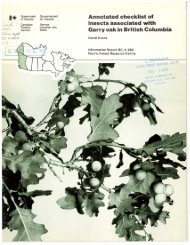
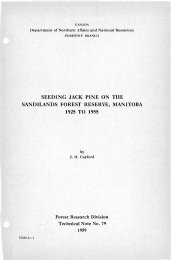
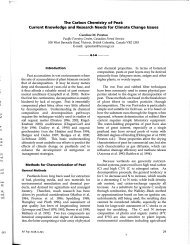


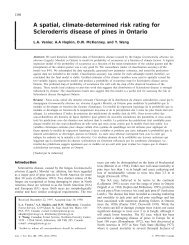

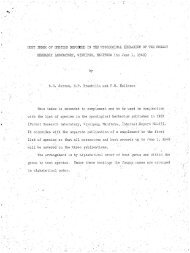
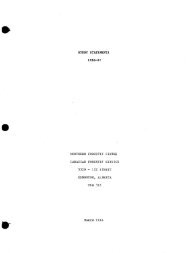
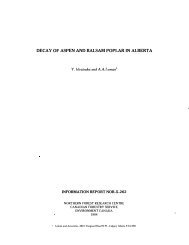
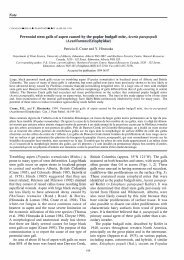
![Po],rell](https://img.yumpu.com/11946277/1/190x231/porell.jpg?quality=85)
